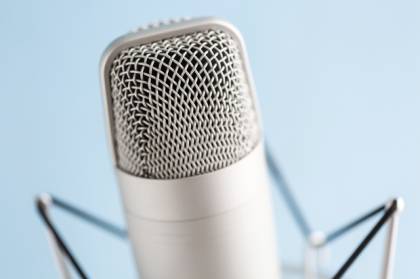You’ve got a microphone. You’ve got some web space. And you have a great idea for a podcast. Now, it’s onto the fun bit — the recording. Even if you've had a couple of false starts, don't worry — this is completely normal, especially if you haven’t had much recording practice. If you're ready to get serious, though, you've come to the right place. This step-by-step tutorial will help you master the art of making your own podcast.

Before beginning to record, and whatever your specific equipment, take time to prepare and give yourself the best chance of a good-quality recording. Ideally, use a room that has plenty of space for you to work and that contains primarily soft furnishings — this cuts down dramatically on echoes/reverb, which can’t really be removed in post-production. If you don’t have such a room, don’t fret. Luckily, podcast audiences don’t demand anything like the level of audio found in music, voice over, or radio work. A little echo is no big deal as long as it’s not unpleasant to listen to, and many people even add some in to provide a more booming radio-voice sound. Even a cupboard-style room with hard walls and wood flooring can be made usable by turning the microphone sensitivity down a little, or, if it really is a problem, hanging up a blanket helps dampen the sound. It’s also possible to invest in a microphone screen/vocal booth for between $100–$270 that essentially wraps acoustic foam around the back of your microphone. Save your money unless you’ve no other option, or are setting up a more general studio.
Now that you have the setup sorted out, it’s time to do a little groundwork — especially if you’re recording with another person and working without a script. Have a list of topics you want to cover, and have a clock or timer running (we use our iPad) to serve as a visible reminder. It’s easy to lose track of time while recording, and to get sidetracked. While a podcast can be any length you like, fifteen minutes is a good length to talk about one subject within a podcast, while half an hour to an hour is a reasonable period for the entire show. Remember, most people listen to podcasts on the move rather than at their computers, and too many breaks and subject changes gets jarring and makes it hard to remember what’s already been said. On the other side, anything under five minutes will be too short for people to invest in, and not worth your effort, either.
Good things to decide and practice in advance include how you’re going to introduce your podcast, as well as the order you plan to introduce guests and how to finish it. Plus, you need to think of a name for it.
Giving the link to your website/podcast host is the obvious starter there, as well as reminding listeners to rate you on iTunes — though this is best saved for a couple of podcasts in. You can ignore other podcast directories at this point.
Finally, don’t forget about yourself. Podcasting can be extremely hard on the voice, especially early on. Always have room-temperature water on standby, and hydrate yourself in advance. As you approach the recording session, avoid soft drinks, milk, coffee, and tea for the sake of your voice and the quality of your recording. And it goes almost without saying — if talking starts feeling uncomfortable, take a break. You can always pick it up later on.
Sign up for breaking news, reviews, opinion, top tech deals, and more.